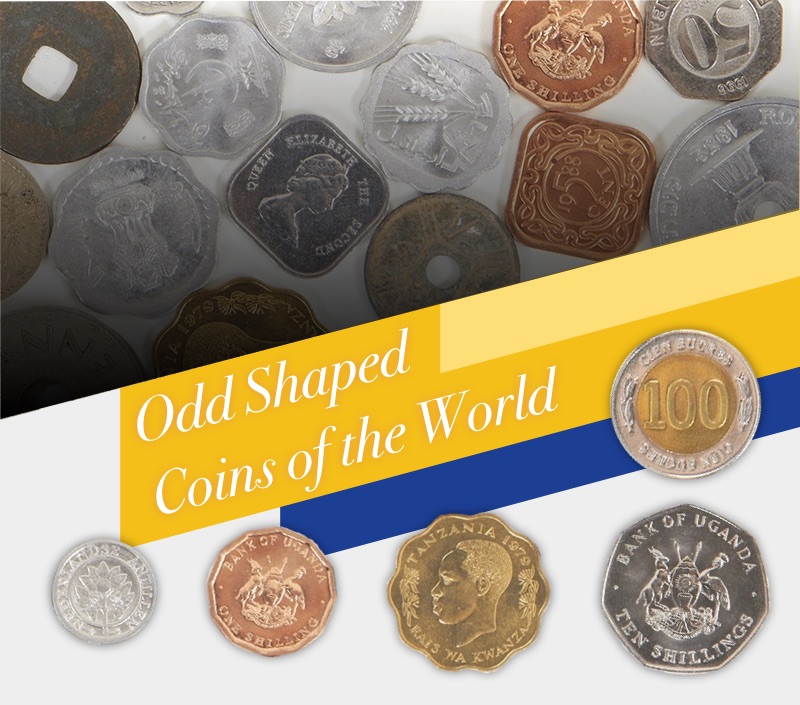Odd Shaped coins of the World

Odd shaped coins are just that. Odd. It is very rare to find one in your pocket change. Ever wondered why?Finding different shapes in your pocket change like a square, a triangle or a 3 dimensional shape would be quite exciting. But these shapes aren't really practical for everyday use. Imagine the inconvenience if a triangular coin gets stuck in a pocket hole. Coins with sharp edges will have more wear in their designs.Historically, it was never intentionally meant for a coin to be round in shape. When two metals at opposite ends were used to strike another piece of metal, the result was a round and thus the circular coin was born.
But mints around the world have experimented with Odd shaped coins for circulating and commemorative purposes. And collectors have found new and exciting coins to collect in these Odd Shaped coins.
Coins with a 'hole'
Ancient Chinese cash coins had a square hole and later circular holes in the center. This was done for stringing them together easily. In modern times, many countries have released coins with a center hole. Some of these countries are Japan, Spain, France, Denmark, Greece and Indonesia.
Japan 5 Yen and 50 Yen
The reason the yen had a hole was originally to save on the material cost. The other practical reasons were to identify a denomination better and to avoid counterfeiting.The 5 yen coin was first released in 1949 with a center hole. The obverse design hasa rice plant symbolizing agriculture, a gear around the hole representing heavy industry and horizontal stripe lines representing fishery. The 50 yen coin has the chrysantheum design in the obverse. Both these coins are circulating coins.
Square Shaped Coins
Many mints have released Square shaped coins for circulation. These coins mostly have rounded edges for better handling. Some coins have corner alignment while others have edge alignment.
Bahamas 15 cents
The Copper-Nickel 15 cent coin from the Bahamas is a square shaped coin. The obverse has a bust of Queen Elizabeth II with tiara and the reverse shows a hibiscus. This is a corner aligned coin.
Australian Kookaburra 50 cents
The 50 cent coin from the Royal Australian mint is a square silver coin depicting the Kookaburra bird. It was released in 2002 as an inspiration from the earlier 1919-21 coins. These 50 cent coins are legal tender in Australia.
ScallopShaped Coins
This beautiful wavy-edged or scallop shaped coins have been released by many countries over the last several years. Some of these countries are the Bahamas, Bangaladesh, Sri Lanka, India, Jamaica, Philippines, and Tanzania. The Scallop shaped coins were minted for the same reason a square shaped coin was minted; to differentiate from other denominations.
Tanzania 10 cents
The Tanzanian 10 cent is a beautiful scallop shaped coin with the head of the state Julius Kambarage Nyerere van Tanzania (1964-1985) in the obverse and a prancing zebra in the reverse with the Senti Kumi (10 cents) written on top of it.
Bangladesh 10 poisha
The Bangladeshi 10 poisha is another scallop shaped coin with the obverse depicting the national emblem, the Water Lily with 2 sheaves of rice on the sides.Above the water lily are tea leaves and four stars representing the four principles of Bangladesh constitution in 1972: nationalism, secularism, socialism, and democracy. The reverse has a grain sprig and a ploughing tractor.
PolygonalShaped Coins
Apart from the regular square shaped coins, there are other Polygonal shapes of coins that come with different number of sides (as in the shape sides, not the obverse and reverse sides!) and sizes. Most are 7 sided, some are 6-, 8-, 10- or even 12-sided coins.
UK 20 and 50pence
The UK 20 and 50 pence coins are equilateral heptagon coins and have been in production for several decades now. The obverse designs of both coins depict Queen Elizabeth II and even though the subject remains the same, the designers have changed over the years. The reverse designs have changed for both the 50p and 20p coins. Currently the designs sport a segmentof the Royal Shield. When all denominations (except for 1 that shows the entire shield) are fitted together like a puzzle, they form the shield in its entirety.
Uganda 10 shillings
The Bank of Uganda 10 shillings coin is a equilaterally curved heptagonal coin. The obverse shows the Ugandan National arms with 'Bank of Uganda' marked on top and 'Ten shillings' marked down. The reverse shows the value of the coin as a number and surrounded by sprigs.
Jamaica 1 dollar
The Jamaican 1 dollar is another equilateral heptagon coin that shows the Jamaican coat of arms in the obverse. The reverse shows the Jamaican National Hero,Rt. Excellent Sir Alexander Bustamante.
REFERENCES
1.https://en.wikipedia.org/wiki/Coin
This entry was posted in World Coins on September 22, 2016 by lavanya kannan

Leave a comment